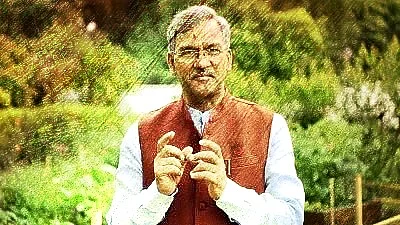Last week, in a private conversation, a senior BJP leader said, “Please note, there are a few lessons to be learnt here. Some people turn a crisis into an opportunity, which is something Prime Minister Narendra Modi is doing, but there are some people like Trivendra Singh Rawat who turn an opportunity into a crisis.”
A bit later he added, “before this crisis hits us hard, costing the party ‘Devbhoomi’ (Uttarakhand) in next elections and much more, we have to find a solution soon.”
This reference to Uttarakhand Chief Minister Trivendra Singh Rawat was made in context of the state government’s preparation for Haridwar Kumbh. The first Shahi Snan is to take place on 11 March, on Mahashivratri.
Has ‘Mismanaging’ the Kumbh Cost Rawat His Office?
While people across the country were curious about Haridwar Kumbh but Uttarakhand administration was making all ‘efforts’ to transform an over a-month-long jamboree into a low-key event. This is turning out be the least talked about Kumbh in recent decades.
Uttarakhand government issued COVID-19 guidelines that could deter devout Hindu religious pilgrims and enthusiastic mela-goers from visiting holiest of holy Haridwar.
Rawat government remained completely unmindful of the fact that not just people from outside but people from the region, as also other stakeholders were eagerly looking forward to the occasion, not just for the manifold business opportunities but also for enhancing social and cultural standing.
Managing the expectations of the devout alongside following COVID-19 protocols proved difficult for Rawat.
But then, politics is the art of possible. The Yogi Adityanath example of management of the Allahabad Kumbh is etched in the memory of both the BJP members as well as their voters. Yogi Adityanath, aka Ajay Singh Bisht, also belong to Uttarakhand.
In addition, Rawat’s alacrity in relief, rescue and rehabilitation in the recent tragedy caused due to Glacier burst near Rishiganga was not considered up to the mark. He did visit the affected areas and met people there but the proactive action mode which the chief minister should have displayed was missing.
This tragedy culminated into loss of human lives, dreams, aspirations, confidence and mega development plan. The need of the hour, thus, was to instil a sense of being cared for by immediate and tangible measures.
Why Uttarakhand is Important for Prime Minister Modi
The outgoing chief minister even failed to realise how deep Prime Minister Narendra Modi’s associations were with Uttarakhand and how closely he had been involved with the state since his adulthood days. He has always iterated a vision for the state. Even after becoming Prime Minister, Modi has visited Kedarnath more than once and laid out a series of centrally-sponsored and centrally-monitored projects.
Days after Modi was appointed as Chairman of the BJP campaign committee for 2014 parliamentary election—a precursor to him being declared the BJP Prime Ministerial candidate—in June 2013, he surprised the nation by landing in Dehradun with experts and logistical support from Gujarat to supervise an unprecedented rescue and relief operation for people truck in the Kedarnath tragedy.
Despite criticism from some quarters, Modi as the then Gujarat chief minister, stayed grounded in Uttarakhand till he accomplished his mission.
Rawat he failed to read the fine prints of even the publicly known scripts authored by his leader. He lacked vision and kept himself occupied with doing patchworks.
Whatever notable projects unfolded were centrally-sponsored schemes initiated under Modi’s guidance.
Some of Rawat’s public statements and behaviour—like ordering the arrest of a lady teacher who had gone to Janata Durbar to seek relief—had upset both the BJP leadership and the public at large. Moreover, delayed response on key issues had left the bureaucracy demoralised.
Gairsain Announcement: The Last Straw?
Through a recent administrative action, Rawat also managed to anger his peers and some senior colleagues in the party from Kumaon. Gairsain, a town in Chamoli district situated between Garhwal and Kumoan region was being planned to be developed as the summer capital of Uttarakhand.
Last week, Rawat sprang a major surprise while presenting the state’s annual budget. He announced that Gairsain would be developed as the third commissionerate comprising of four hill districts: Chamoli and Rudraprayag (from Garhwal) and Almora and Bageshwar (from Kumaon).
The announcement angered senior party leaders from Kumaon—like Bhagat Singh Koshiyari and Ajay Bhatt—and also host of other people from the region. So far, Garhwal and Kumaon were the two commissionerates in Uttarakhand with distinct cultural and social identities. Almora is taken as centre of Kumaon’s social and cultural identity.
Rawat’s announcement for Gairsain proved to be the proverbial last straw.
Is Rawat’s Removal Good for the BJP?
There was widespread resentment building against Rawat among people. The central leadership was conscious of it. It was felt by the BJP leadership that with Rawat at the helm even Modi’s magic wouldn’t be able to salvage the situation for the party in Uttarakhand. By removing Rawat, the BJP has neutralised rising popular anger.
BJP leadership in Delhi acted swiftly. When Raman Singh, former Chattisgarh Chief Minister and party vice-president was asked to go to Dehradun to make an on-spot assessment and meet the MLAs individually, Rawat was not informed. Once the decision was made, Rawat was summoned to Delhi and politely told to resign.
The BJP has taken lessons from Rajasthan and Jharkhand—two states where the leadership retained Vasundhara Raje and Raghubar Das ignoring reports of massive popular resentment against them. The party had lost both these states on account of anti-incumbency against the state leadership.
Rawat would have not-so-honourable distinction of being the first chief minister of a BJP ruled state since 2014 who was removed by the leadership due to dissidence and non-performance.
(The author is a senior journalist and tweets @sanjays04. This is an opinion piece. The views expressed above are the author’s own. The Quint neither endorses nor is responsible for them.)
(At The Quint, we question everything. Play an active role in shaping our journalism by becoming a member today.)
